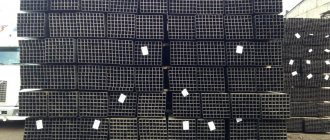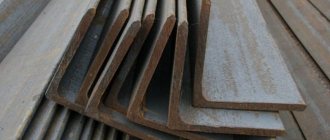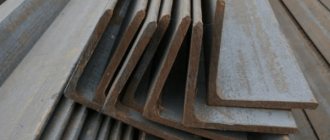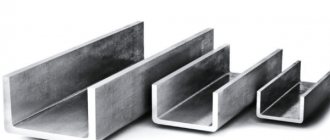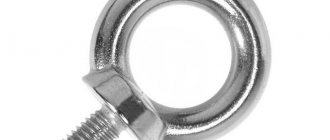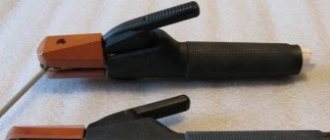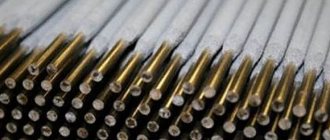A steel corner 50x50x5 is a metal product with a cross-section in the shape of the letter G. The corner profile can have a small cross-sectional area (1-1.5 sq. cm) and a large one (up to 140 sq. cm).
Steel corner 50x50x5 is used to create building structures with welded or other types of connections. In addition, this profile is used for finishing external corners, as well as as a decorative element.
In accordance with the accepted standard, an equal angle corner (GOST 8509-93) and an unequal angle angle (GOST 8510-86) are manufactured. Both positions are performed with rolling accuracy A (high accuracy) or B (normal accuracy).
The range of equal-flange angles is made of a special type of steel, which provides high stability and is characterized by good resistance to intense loads. The equal-flange steel angle has a standard length from 4 to 12 m.
The 50x50x5 steel unequal angle has a specific scope of application and is in less demand than the equal angle angle, the scope of which is extensive. Unequal flange is used as one of the elements in a load-bearing metal structure, as well as for decorative finishing, bonding, and lining. We offer an assortment of “unequal-flanged angles”, manufactured on roll forming equipment from cold-rolled and hot-rolled sheets. You can view the full selection of products in our catalog or price list.
offers hot-rolled steel angles, equal and unequal, in a large assortment and in accordance with standard requirements.
Weight of steel hot-rolled equal-flange angle GOST 8509-93
| Angle dimensions | Corner flange size A, mm | Metal thickness S, mm | Weight m/p., kg | Number of meters in tons |
| 20×3 | 20 | 3 | 0.89 | 1123.6 |
| 20×4 | 20 | 4 | 1.15 | 869.57 |
| 25×3 | 25 | 3 | 1.12 | 892.86 |
| 25×4 | 25 | 4 | 1.46 | 684.93 |
| 25×5 | 25 | 5 | 1.78 | 561.8 |
| 28×3 | 28 | 3 | 1.27 | 787.4 |
| 30×3 | 30 | 3 | 1.36 | 735.29 |
| 30×4 | 30 | 4 | 1.78 | 561.8 |
| 30×5 | 30 | 5 | 2.18 | 458.72 |
| 32×3 | 32 | 3 | 1.46 | 684.93 |
| 32×4 | 32 | 4 | 1.91 | 523.56 |
| 35×3 | 35 | 3 | 1.6 | 625 |
| 35×4 | 35 | 4 | 2.1 | 476.19 |
| 35×5 | 35 | 5 | 2.58 | 387.6 |
| 40×3 | 40 | 3 | 1.85 | 540.54 |
| 40×4 | 40 | 4 | 2.42 | 413.22 |
| 40×5 | 40 | 5 | 2.98 | 335.57 |
| 40×6 | 40 | 6 | 3.52 | 284.09 |
| 45×3 | 45 | 3 | 2.08 | 480.77 |
| 45×4 | 45 | 4 | 2.73 | 366.3 |
| 45×5 | 45 | 5 | 3.37 | 296.74 |
| 45×6 | 45 | 6 | 3.99 | 250.63 |
| 50×3 | 50 | 3 | 2.32 | 431.03 |
| 50×4 | 50 | 4 | 3.05 | 327.87 |
| 50×5 | 50 | 5 | 3.77 | 265.25 |
| 50×6 | 50 | 6 | 4.47 | 223.71 |
| 50×7 | 50 | 7 | 5.15 | 194.17 |
| 50×8 | 50 | 8 | 5.82 | 171.82 |
| 56×4 | 56 | 4 | 3.44 | 290.7 |
| 56×5 | 56 | 5 | 4.25 | 235.29 |
| 60×4 | 60 | 4 | 3.71 | 269.54 |
| 60×5 | 60 | 5 | 4.58 | 218.34 |
| 60×6 | 60 | 6 | 5.43 | 184.16 |
| 60×8 | 60 | 8 | 7.1 | 140.85 |
| 60×0 | 60 | 10 | 8.7 | 114.94 |
| 63×4 | 63 | 4 | 3.9 | 256.41 |
| 63×5 | 63 | 5 | 4.81 | 207.9 |
| 63×6 | 63 | 6 | 5.72 | 174.83 |
| 65×6 | 65 | 6 | 5.91 | 169.2 |
| 65×8 | 65 | 8 | 7.73 | 129.37 |
| 70×4 | 70 | 4.5 | 4.87 | 205.34 |
| 70×5 | 70 | 5 | 5.38 | 185.87 |
| 70×6 | 70 | 6 | 6.39 | 156.49 |
| 70×7 | 70 | 7 | 7.39 | 135.32 |
| 70×8 | 70 | 8 | 8.37 | 119.47 |
| 70×0 | 70 | 10 | 10.29 | 97.18 |
| 75×5 | 75 | 5 | 5.8 | 172.41 |
| 75×6 | 75 | 6 | 6.89 | 145.14 |
| 75×7 | 75 | 7 | 7.96 | 125.63 |
| 75×8 | 75 | 8 | 9.02 | 110.86 |
| 75×9 | 75 | 9 | 10.07 | 99.3 |
| 80×5 | 80 | 5.5 | 6.78 | 147.49 |
| 80×6 | 80 | 6 | 7.36 | 135.87 |
| 80×7 | 80 | 7 | 8.51 | 117.51 |
| 80×8 | 80 | 8 | 9.65 | 103.63 |
| 80×10 | 80 | 10 | 11.88 | 84.18 |
| 80×12 | 80 | 12 | 14.05 | 71.17 |
| 90×6 | 90 | 6 | 8.33 | 120.05 |
| 90×7 | 90 | 7 | 9.64 | 103.73 |
| 90×8 | 90 | 8 | 10.93 | 91.49 |
| 90×9 | 90 | 9 | 12.2 | 81.97 |
| 90×10 | 90 | 10 | 13.48 | 74.18 |
| 90×12 | 90 | 12 | 15.96 | 62.66 |
| 100×6.5 | 100 | 6.5 | 10.06 | 99.4 |
| 100×7 | 100 | 7 | 10.79 | 92.68 |
| 100×8 | 100 | 8 | 12.25 | 81.63 |
| 100×10 | 100 | 10 | 15.1 | 66.23 |
| 100×12 | 100 | 12 | 17.9 | 55.87 |
| 100×14 | 100 | 14 | 20.63 | 48.47 |
| 100×15 | 100 | 15 | 21.97 | 45.52 |
| 100×16 | 100 | 16 | 23.3 | 42.92 |
| 110×7 | 110 | 7 | 11.89 | 84.1 |
| 110×8 | 110 | 8 | 13.5 | 74.07 |
| 120×8 | 120 | 8 | 14.76 | 67.75 |
| 120×10 | 120 | 10 | 18.24 | 54.82 |
| 120×12 | 120 | 12 | 21.67 | 46.15 |
| 120×15 | 120 | 15 | 26.68 | 37.48 |
| 125×8 | 125 | 8 | 15.46 | 64.68 |
| 125×9 | 125 | 9 | 17.3 | 57.8 |
| 125×10 | 125 | 10 | 19.1 | 52.36 |
| 125×12 | 125 | 12 | 22.68 | 44.09 |
| 125×14 | 125 | 14 | 26.2 | 38.17 |
| 125×16 | 125 | 16 | 29.65 | 33.73 |
| 140×9 | 140 | 9 | 19.41 | 51.52 |
| 140×10 | 140 | 10 | 21.45 | 46.62 |
| 140×12 | 140 | 12 | 25.5 | 39.22 |
| 150×10 | 150 | 10 | 23.02 | 43.44 |
| 150×12 | 150 | 12 | 27.39 | 36.51 |
| 150×15 | 150 | 15 | 33.82 | 29.57 |
| 150×18 | 150 | 18 | 40.11 | 24.93 |
| 160×10 | 160 | 10 | 24.67 | 40.54 |
| 160×11 | 160 | 11 | 27.02 | 37.01 |
| 160×12 | 160 | 12 | 28.35 | 35.27 |
| 160×14 | 160 | 14 | 33.97 | 29.44 |
| 160×16 | 160 | 16 | 38.52 | 25.96 |
| 160×18 | 160 | 18 | 43.01 | 23.25 |
| 160×20 | 160 | 20 | 47.44 | 42968 |
| 180×11 | 180 | 11 | 30.47 | 32.82 |
| 180×12 | 180 | 12 | 33.12 | 30.19 |
| 180×15 | 180 | 15 | 40.96 | 24.41 |
| 180×18 | 180 | 18 | 48.66 | 20.55 |
| 180×20 | 180 | 20 | 53.72 | 18.62 |
| 200×12 | 200 | 12 | 36.97 | 42882 |
| 200×13 | 200 | 13 | 39.92 | 42880 |
| 200×14 | 200 | 14 | 42.8 | 23.36 |
| 200×16 | 200 | 16 | 48.65 | 20.55 |
| 200×18 | 200 | 18 | 54.4 | 18.38 |
| 200×20 | 200 | 20 | 60.08 | 16.64 |
| 200×24 | 200 | 24 | 71.26 | 42808 |
| 200×25 | 200 | 25 | 74.02 | 13.51 |
| 200×30 | 200 | 30 | 87.56 | 15646 |
| 220×14 | 220 | 14 | 47.4 | 42756 |
| 220×16 | 220 | 16 | 53.83 | 18.58 |
| 250×16 | 250 | 16 | 61.55 | 16.25 |
| 250×18 | 250 | 18 | 68.86 | 14.52 |
| 250×20 | 250 | 20 | 76.11 | 13.14 |
| 250×22 | 250 | 22 | 83.31 | 12 |
| 250×25 | 250 | 25 | 93.97 | 23651 |
| 250×28 | 250 | 28 | 104.5 | 21064 |
| 250×30 | 250 | 30 | 111.44 | 35643 |
| 250×35 | 250 | 35 | 128.51 | 28672 |
Varieties of equal-flange steel angles
Equal angle corners are divided into several categories depending on the manufacturing method and the raw materials used for their production. All geometric parameters, as well as permissible deviations for them, are regulated by two regulatory documents:
- GOST 8509-93 (production of hot-rolled equal-flange angles);
- GOST 19771-93 (production of equal-flange steel angles obtained by bending).
You can familiarize yourself with the GOST requirements and the range of hot-rolled and bent equal-flange steel angles by downloading the relevant documents in pdf format from the links below.
The difference between equal-shelf and unequal-shelf products is that the former have shelves of the same dimensions (width), while the latter have different shelves. Hot-rolled corner profiles are manufactured using the following technology: a hot billet is rolled between the shafts of a special rolling mill, where, under pressure, it is formed into a product with the required geometric shape and dimensions.
In order to produce a metal corner of the bent type, rolled sheets of the appropriate size are bent on roll forming equipment or on pipe mills. Due to the peculiarities of their production, hot-rolled profiles are characterized by higher strength, but bent corners also have their advantages: high dimensional accuracy, light weight, wide range.
The range of equal angle angles includes products from:
- high strength steel;
- alloyed, high-alloy steel;
- alloys characterized by increased heat resistance, heat resistance and corrosion resistance.
The most common material for the production of bent angles is also carbon steel, the characteristics of which must comply with GOST 380-94.
Weight of hot-rolled steel unequal angle GOST 8510-96
| Angle dimensions | Corner flange size A, mm | Corner flange size B, mm | Metal thickness S, mm | Weight m/p., kg | Number of meters in tons |
| 25×16×3 | 25 | 16 | 3 | 0.91 | 1098.9 |
| 30×20×3 | 30 | 20 | 3 | 1.12 | 892.86 |
| 30×20×4 | 30 | 20 | 4 | 1.45 | 689.66 |
| 32×20×3 | 32 | 20 | 3 | 1.17 | 854.7 |
| 32×20×4 | 32 | 20 | 4 | 1.52 | 657.89 |
| 40×25×3 | 40 | 25 | 3 | 1.48 | 675.68 |
| 40×25×4 | 40 | 25 | 4 | 1.94 | 515.46 |
| 40×25×5 | 40 | 25 | 5 | 2.37 | 421.94 |
| 40×30×4 | 40 | 30 | 4 | 2.26 | 442.48 |
| 40×30×5 | 40 | 30 | 5 | 2.46 | 406.5 |
| 45×28×3 | 45 | 28 | 3 | 1.68 | 595.24 |
| 45×28×4 | 45 | 28 | 4 | 2.2 | 454.55 |
| 50×32×3 | 50 | 32 | 3 | 1.9 | 526.32 |
| 50×32×4 | 50 | 32 | 4 | 2.4 | 416.67 |
| 56×36×4 | 56 | 36 | 4 | 2.81 | 355.87 |
| 56×36×5 | 56 | 36 | 5 | 3.46 | 289.02 |
| 63×40×4 | 63 | 40 | 4 | 3.17 | 315.46 |
| 63×40×5 | 63 | 40 | 5 | 3.91 | 255.75 |
| 63×40×6 | 63 | 40 | 6 | 4.63 | 215.98 |
| 63×40×8 | 63 | 40 | 8 | 6.03 | 165.84 |
| 65×50×5 | 65 | 50 | 5 | 4.36 | 229.36 |
| 65×50×6 | 65 | 50 | 6 | 5.18 | 193.05 |
| 65×50×7 | 65 | 50 | 7 | 5.93 | 168.63 |
| 65×50×8 | 65 | 50 | 8 | 6.77 | 147.71 |
| 70×45×5 | 70 | 45 | 5 | 4.3 | 232.56 |
| 75×60×5 | 75 | 60 | 5 | 4.79 | 208.77 |
| 75×60×6 | 75 | 60 | 6 | 5.69 | 175.75 |
| 75×60×7 | 75 | 60 | 7 | 6.57 | 152.21 |
| 75×60×8 | 75 | 60 | 8 | 7.43 | 134.59 |
| 80×50×5 | 80 | 50 | 5 | 4.49 | 222.72 |
| 80×50×6 | 80 | 50 | 6 | 5.92 | 168.92 |
| 80×60×6 | 80 | 60 | 6 | 6.39 | 156.49 |
| 80×60×7 | 80 | 60 | 7 | 7.39 | 135.32 |
| 80×60×8 | 80 | 60 | 8 | 8.37 | 119.47 |
| 90×56×5 | 90 | 56 | 5.5 | 6.17 | 162.07 |
| 90×56×6 | 90 | 56 | 6 | 6.7 | 149.25 |
| 90×56×8 | 90 | 56 | 8 | 8.77 | 114.03 |
| 100×63×6 | 100 | 63 | 6 | 7.53 | 132.8 |
| 100×63×7 | 100 | 63 | 7 | 8.7 | 114.94 |
| 100×63×8 | 100 | 63 | 8 | 9.87 | 101.32 |
| 100×63×10 | 100 | 63 | 10 | 12.14 | 82.37 |
| 100×65×7 | 100 | 65 | 7 | 8.81 | 113.51 |
| 100×65×8 | 100 | 65 | 8 | 9.99 | 100.1 |
| 100×65×10 | 100 | 65 | 10 | 12.3 | 81.3 |
| 110×70×6 | 110 | 70 | 6.5 | 8.98 | 111.36 |
| 110×70×8 | 110 | 70 | 8 | 10.93 | 91.49 |
| 125×80×7 | 125 | 80 | 7 | 11.04 | 90.58 |
| 125×80×8 | 125 | 80 | 8 | 12.58 | 79.49 |
| 125×80×10 | 125 | 80 | 10 | 15.47 | 64.64 |
| 125×80×12 | 125 | 80 | 12 | 18.34 | 54.53 |
| 140×90×8 | 140 | 90 | 8 | 14.13 | 70.77 |
| 140×90×10 | 140 | 90 | 10 | 17.46 | 57.27 |
| 160×100×9 | 160 | 100 | 9 | 17.96 | 55.68 |
| 160×100×10 | 160 | 100 | 10 | 19.85 | 50.38 |
| 160×100×12 | 160 | 100 | 12 | 23.58 | 42.41 |
| 160×100×14 | 160 | 100 | 14 | 27.26 | 36.68 |
| 180×110×10 | 180 | 110 | 10 | 22.2 | 45.05 |
| 180×110×12 | 180 | 110 | 12 | 26.4 | 37.88 |
| 200×125×11 | 200 | 125 | 11 | 27.37 | 36.54 |
| 200×125×12 | 200 | 125 | 12 | 29.74 | 33.62 |
| 200×125×14 | 200 | 125 | 14 | 34.43 | 42854 |
| 200×125×16 | 200 | 125 | 16 | 39.07 | 42911 |
How a corner is made - differences in products
Many uses have been invented for the standard L-shaped profile of a steel corner, which is understandable - the bending point is at the same time a stiffening rib and a convenient shape for laying corners on other surfaces. A popular type of rolled product is made mainly from ordinary carbon steel, less often from high-quality structural steel. Over the years, the production of steel angles has acquired many GOSTs, for example, general requirements and characteristics for the product are present in GOST 19771-93, while each type and method of rolling has its own separate GOST.
Hot rolled angle is produced by rolling a bloom (an ingot of metal) through a series of rotating shafts that apply the required pressure to the hot metal. During the movement, an L-shape without a radius on the outside is also formed. There is a radius on the inside - it plays the important role of an additional stiffener. According to GOST 8509-93, maximum deviations from the length of angles on sale should be no more than 0.75% of those declared by the manufacturer, and the curvature coefficient should be no more than 0.4% of the length.
The technology of cold-rolled production is significantly different - basically, angles are made from metal strips (ordinary steel) on roll forming machines, or strip blanks are rolled through a series of shafts. Due to their higher cost, such products are not suitable for creating load-bearing and monolithic structures; their scope of application is limited mainly to finishing work. The range is represented by products from 6 to 12 meters. Externally, it is very simple to distinguish cold-rolled products from hot-rolled ones - the former do not have the scale characteristic of the latter.
Application areas of metal corners
- In homestead construction. Angular steel is used for the construction of large-sized greenhouses and small greenhouses, fences with chain-link mesh, portable and stationary gazebos.
- When constructing stairs - internal and external. The corner can be used for the manufacture of such metal products as step frames, porch platform frames, porch supports, stair railings.
- For strengthening window and door openings in brick or block masonry. The use of steel corner bars prevents the appearance of cracks in the wall and thereby extends the service life of the entire building.
- Production of canopies, street structures (benches, tables, swings), frames for bars on doors and windows, wickets, gates.
- Manufacturing of shelving in warehouses and in production , cabinet frames, trolleys, workbenches, various production equipment - testing and assembly stands.
- In everyday life - frames of metal doors, household brick stoves.
The widespread use of metal angles in construction provides the following advantages of rolled steel: a combination of strength and low weight, ease of transportation, storage and installation, durability subject to anti-corrosion treatment.
How to choose steel angles?
So, how should you choose the right metal corners?
The first is accuracy. You can recognize it by the letter in the marking. If there is a letter A, then this means that the corner has high accuracy. If Latin B is indicated, this means that this product has normal accuracy.
What can this parameter actually affect? It shows the parameters of the finished product (evenness, accuracy, thickness, as well as any deviations).
For small rolled metal products, high accuracy is an important characteristic. But for large products, completely different characteristics are important.
The second is the manufacturing methods. There are two types of manufacturing - cold rolling and hot rolling. That is, during hot production, products are rolled in special forms through hot machines (or the finished product is bent).
If we compare a cold-rolled product with a hot-rolled one, the former have low strength. Therefore, if high strength is required, then this steel angle will not work; it is better not to purchase it.
The third thing to pay attention to is the shelves. There are two types - equilateral and non-equilateral. Option No1 is a metal strip that has an angle of 90% in the middle. The second No2 resembles the letter G because one side is longer than the other.
Corners that have equal sides are stronger, so they are used more often. But if it is necessary to individually calculate the length of both shelves, then non-equilateral corners are used here. This option also has high reinforcing properties.
And fourth is the steel from which the corners are made. In the manufacture of metal corners, more than one type of steel is used. If ordinary steel was used in the manufacture of the corner, then its price will be lower.
If in construction it is necessary for the structure to be reliable, so that it is not affected by the environment and temperature changes, then you should opt for products made of low-alloy steel.
Types of metal corners
Hot rolled. It is made from a finished steel billet, which is heated and passed through a machine. And according to the dimensions that are given, the product is formed.
Bent. This type is made from a strip of steel; it can be used either cold or hot rolling, during which a bend is formed. This corner will suit any design idea.
Equal. The name speaks for itself. All sides of this angle are equal.
Unequal. This corner has different side sizes.
The metal corner has standard dimensions:
- 20x20 mm;
- 25x25mm;
- 50x50mm;
- 70x70mm;
- 75x75mm;
- 100x100mm;
- 120x120mm;
- 150x150mm;
- 200x200mm.
You can also classify metal corners by length. There are two types. This:
- Measured;
- Unmeasured.
The lengths of measuring metal corners are 6,7,9,10,11 and 12 mm. The price of this product varies not by unit, but by weight category. That is, the buyer will pay not for the quantity of products, but for its weight.
Unmeasured metal corners can have different lengths. Typically it varies from 4 to 12 mm.
Steel angle - strictly according to GOST
Based on the cross-sectional type, products are divided into equal-flange and unequal-flange. The shelf of an angle is one of its sides, to put it in plain language. Equal-sex ones, as the name suggests, have identical shelves, which cannot be said about unequal-sex ones. The range of the latter is limited and is often made to order.
The shelf width varies from 20 mm to 200 mm, the metal thickness reaches a maximum of 16 mm. The weight of a steel angle is measured in kilograms per meter, for example, for an equal-flange product with a shelf width of 20 mm and a metal thickness of 3 mm, the weight will be 0.890 kg/m. For the largest representative of this family - a two-hundred-millimeter product - with a thickness of 12 mm, the weight will be about 37 kg/m.
According to the accuracy class, corners are divided into high-precision products, also known as class A, and ordinary accuracy, class B. Products are numbered depending on the width of the shelf, which is measured in millimeters. The standard length of products is from six to twelve meters, this is not counting the unmeasured length, the minimum value of which is 4 meters. When producing large batches of a strictly defined size, according to GOST, 15% of oversized products are allowed.
